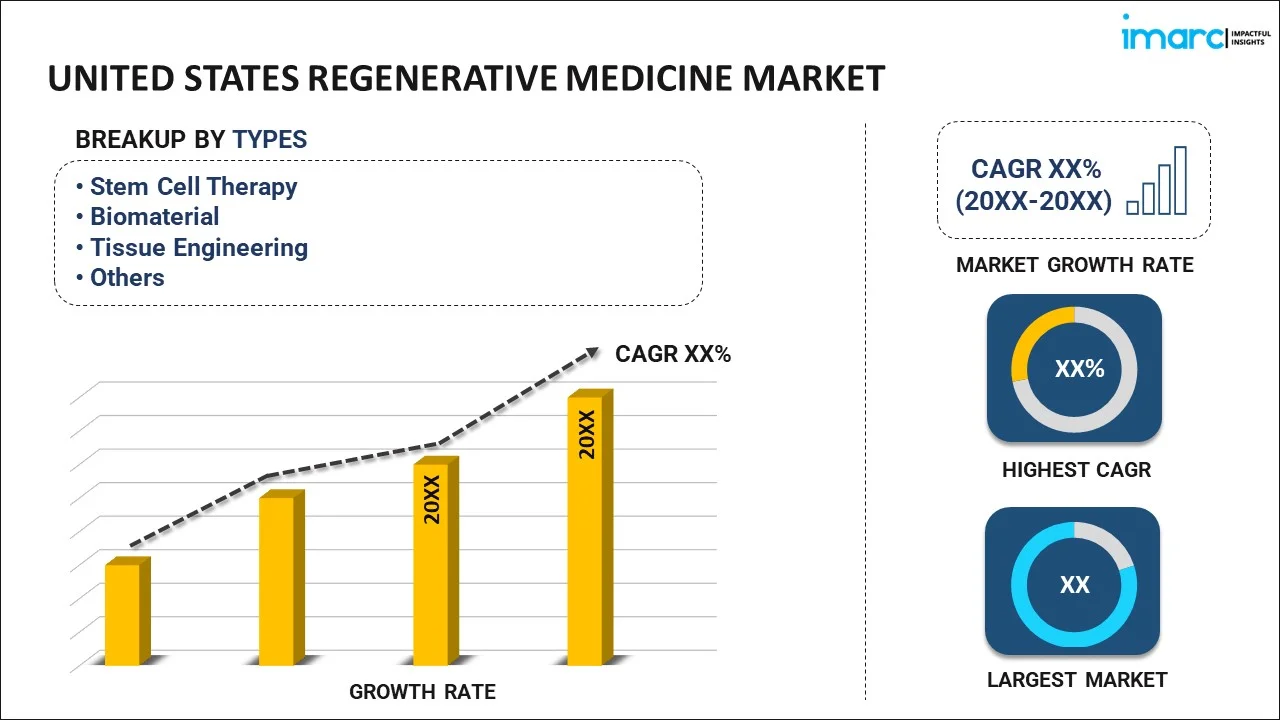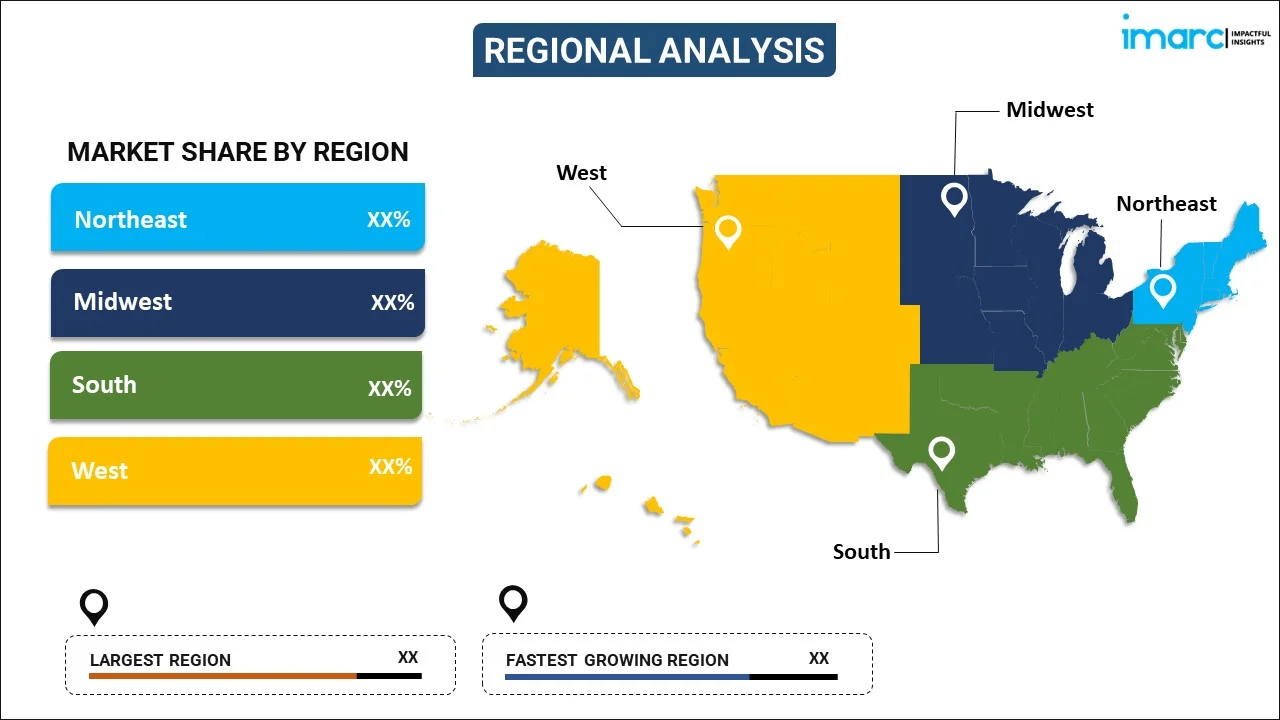
United States Regenerative Medicine Market Report by Type (Stem Cell Therapy, Biomaterial, Tissue Engineering, and Others), Application (Bone Graft Substitutes, Osteoarticular Diseases, Dermatology, Cardiovascular, Central Nervous System, and Others), End User (Hospitals, Specialty Clinics, and Others), and Region 2025-2033
Market Overview:
United States regenerative medicine market size reached USD 10.4 Billion in 2024. Looking forward, IMARC Group expects the market to reach USD 43.3 Billion by 2033, exhibiting a growth rate (CAGR) of 15.6% during 2025-2033. The increasing demand for innovative therapeutic solutions, advancements in stem cell research, rising geriatric population, a favorable regulatory landscape, precision medicine focus, collaborative partnerships and substantial financial support, pandemic-driven research, and expanding clinical applications represent some of the key factors driving the market.
|
Report Attribute
|
Key Statistics
|
|---|---|
|
Base Year
|
2024
|
|
Forecast Years
|
2025-2033
|
|
Historical Years
|
2019-2024
|
|
Market Size in 2024
|
USD 10.4 Billion |
|
Market Forecast in 2033
|
USD 43.3 Billion |
| Market Growth Rate 2025-2033 | 15.6% |
Regenerative medicine is a multidisciplinary field of medical science focused on harnessing the body’s innate regenerative capabilities to repair, replace, or restore damaged tissues and organs. This innovative approach involves the use of stem cells, tissue engineering, and molecular biology to stimulate the body’s natural healing processes. Stem cells, with their unique ability to differentiate into various cell types, play a central role in regenerative medicine. Researchers and clinicians explore the potential of stem cells to regenerate tissues and organs affected by injuries, diseases, or congenital disorders. Additionally, tissue engineering involves creating artificial organs or tissues using a combination of cells, biomaterials, and biochemical factors. Regenerative medicine holds promise for treating a wide range of conditions, including heart disease, neurodegenerative disorders, diabetes, and orthopedic injuries. The field continues to evolve rapidly, with ongoing research aimed at refining techniques, understanding cellular behavior, and developing new therapeutic approaches to revolutionize healthcare by providing regenerative solutions for currently incurable conditions.
United States Regenerative Medicine Market Trends:
The United States regenerative medicine market is experiencing remarkable growth driven by the increasing prevalence of chronic diseases and degenerative disorders, such as cardiovascular diseases (CVDs), diabetes, and orthopedic ailments. Besides this, ongoing advancements in stem cell research and technologies have expanded the therapeutic applications of regenerative medicine, allowing for more targeted and effective treatments thereby creating a favorable outlook for market expansion. Moreover, the aging population in the United States is strengthening the market growth, as older individuals often experience a higher incidence of age-related conditions that could benefit from regenerative interventions. In confluence with this, the escalating healthcare costs associated with chronic disease management have incentivized the exploration of regenerative medicine as a cost-effective and potentially curative alternative to traditional treatments, aiding in market expansion. Concurrently, the supportive regulatory landscape, with governing bodies such as the Food and Drug Administration (FDA) providing clearer pathways for the development and approval of regenerative therapies, is acting as another significant growth-inducing factor. In addition to this, the growing focus on precision medicine and personalized therapies has fueled interest in regenerative medicine, as it allows for tailored treatments based on individual patient characteristics, providing an impetus to the market growth. Furthermore, the increasing awareness and acceptance of regenerative medicine and extensive collaborations and partnerships between research institutions, biotechnology companies, and academic centers fostering innovation are contributing to the market's expansion. Apart from this, continuous advancements in tissue engineering and three-dimensional (3D) printing technologies have enhanced the ability to create complex tissues and organs, expanding the potential applications of regenerative medicine.
United States Regenerative Medicine Market Segmentation:
IMARC Group provides an analysis of the key trends in each segment of the market, along with forecasts at the country level for 2025-2033. Our report has categorized the market based on type, application, and end user.
Type Insights:

- Stem Cell Therapy
- Biomaterial
- Tissue Engineering
- Others
The report has provided a detailed breakup and analysis of the market based on the type. This includes stem cell therapy, biomaterial, tissue engineering, and others.
Application Insights:
- Bone Graft Substitutes
- Osteoarticular Diseases
- Dermatology
- Cardiovascular
- Central Nervous System
- Others
A detailed breakup and analysis of the market based on the application have also been provided in the report. This includes bone graft substitutes, osteoarticular diseases, dermatology, cardiovascular, central nervous system, and others.
End User Insights:
- Hospitals
- Specialty Clinics
- Others
The report has provided a detailed breakup and analysis of the market based on the end user. This includes hospitals, specialty clinics, and others.
Regional Insights:

- Northeast
- Midwest
- South
- West
The report has also provided a comprehensive analysis of all the major regional markets, which include the Northeast, Midwest, South, and West.
Competitive Landscape:
The market research report has also provided a comprehensive analysis of the competitive landscape in the market. Competitive analysis such as market structure, key player positioning, top winning strategies, competitive dashboard, and company evaluation quadrant has been covered in the report. Also, detailed profiles of all major companies have been provided.
United States Regenerative Medicine Market Report Coverage:
| Report Features | Details |
|---|---|
| Base Year of the Analysis | 2024 |
| Historical Period | 2019-2024 |
| Forecast Period | 2025-2033 |
| Units | Billion USD |
| Scope of the Report | Exploration of Historical and Forecast Trends, Industry Catalysts and Challenges, Segment-Wise Historical and Predictive Market Assessment:
|
| Types Covered | Stem Cell Therapy, Biomaterial, Tissue Engineering, Others |
| Applications Covered | Bone Graft Substitutes, Osteoarticular Diseases, Dermatology, Cardiovascular, Central Nervous System, Others |
| End Users Covered | Hospitals, Specialty Clinics, Others |
| Regions Covered | Northeast, Midwest, South, West |
| Customization Scope | 10% Free Customization |
| Post-Sale Analyst Support | 10-12 Weeks |
| Delivery Format | PDF and Excel through Email (We can also provide the editable version of the report in PPT/Word format on special request) |
Key Questions Answered in This Report:
- How has the United States regenerative medicine market performed so far and how will it perform in the coming years?
- What has been the impact of COVID-19 on the United States regenerative medicine market?
- What is the breakup of the United States regenerative medicine market on the basis of type?
- What is the breakup of the United States regenerative medicine market on the basis of application?
- What is the breakup of the United States regenerative medicine market on the basis of end user?
- What are the various stages in the value chain of the United States regenerative medicine market?
- What are the key driving factors and challenges in the United States regenerative medicine?
- What is the structure of the United States regenerative medicine market and who are the key players?
- What is the degree of competition in the United States regenerative medicine market?
Key Benefits for Stakeholders:
- IMARC’s industry report offers a comprehensive quantitative analysis of various market segments, historical and current market trends, market forecasts, and dynamics of the United States regenerative medicine market from 2019-2033.
- The research report provides the latest information on the market drivers, challenges, and opportunities in the United States regenerative medicine market.
- Porter's five forces analysis assist stakeholders in assessing the impact of new entrants, competitive rivalry, supplier power, buyer power, and the threat of substitution. It helps stakeholders to analyze the level of competition within the United States regenerative medicine industry and its attractiveness.
- Competitive landscape allows stakeholders to understand their competitive environment and provides an insight into the current positions of key players in the market.
Need more help?
- Speak to our experienced analysts for insights on the current market scenarios.
- Include additional segments and countries to customize the report as per your requirement.
- Gain an unparalleled competitive advantage in your domain by understanding how to utilize the report and positively impacting your operations and revenue.
- For further assistance, please connect with our analysts.

 Inquire Before Buying
Inquire Before Buying
 Speak to an Analyst
Speak to an Analyst
 Request Brochure
Request Brochure
 Request Customization
Request Customization



.webp)




.webp)












